These Solutions are part of NCERT Solutions for Class 12 Biology. Here we have given NCERT Solutions for Class 12 Biology Chapter 3 Human Reproduction
Class 12 Biology Chapter 3 Human Reproduction NCERT Solutions
Human Reproduction NCERT Solutions
Question 1.
Fill in the blanks.
- Humans reproduce___(asexually/ sexually).
- Humans are ___(oviparous/ viviparous/ ovoviviparous).
- Fertilisation is___in humans (external/internal).
- Male and female gametes are___ (diploid/haploid).
- Zygote is___(diploid/haploid).
- The process of release of ovum from a mature follicle is called___
- Ovulation is induced by a hormone called ___
- The fusion of male and female gametes is called___
- Fertilisation takes place in ___
- Zygote divides to form___which is implanted in uterus.
- The structure which provides vascular connection between foetus and uterus is called ___
Solution:
- sexually;
- viviparous;
- internal;
- haploid;
- diploid;
- ovulation;
- LH;
- fertilisation;
- ampullary-isthmic junction of Fallopian tube;
- blastocyst;
- placenta
Question 2.
Draw a labelled diagram of male reproductive system.
Solution:
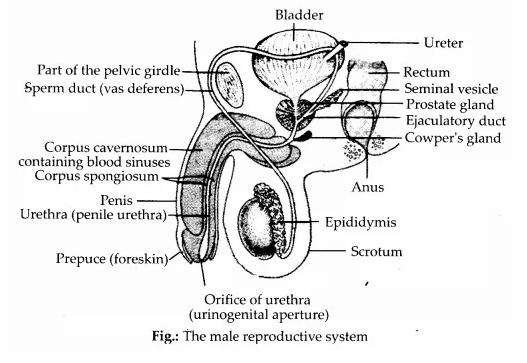
Question 3.
Draw a labelled diagram of female reproductive system.
Solution:
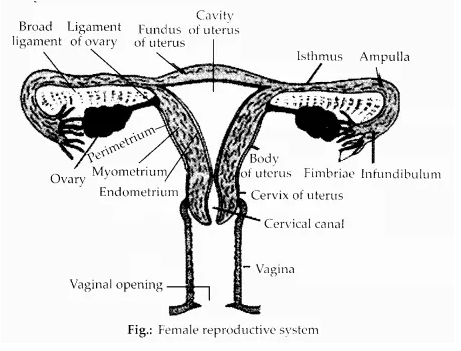
Question 4.
Write two major functions each of testis and ovary.
Solution:
Testis:
- The seminiferous tubules of the testis produce sperm.
- The Leydig cells of testis produce hormones such as androsterone and testosterone, together called androgens.
Ovary:
- Produce ovum
- Produce ovarian hormones such as estradiol, estrone, and estriol collectively called estrogens.
Practicing with NCLEX RN Practice Questions promotes active learning and retention of nursing knowledge in long-term memory.
Question 5.
Describe the structure of a seminiferous tubule
Solution:
Seminiferous tubules are located in the testicles, and are the specific location of meiosis, and the subsequent creation of gametes, namely spermatozoa.
The lining of seminiferous tubules called germinal epithelium contains two types of cells – primary germ ceils which undergo spermatogenesis to form spermatozoa and columnar indifferent cells (derived from coelomic epithelium) which enlarge to form Sertoli cells. Sertoli cells function as nurse cells for providing nourishment to the developing spermatozoa, phagocvtise defective sperm and secrete protein hormone inhibin (which inhibits FSH secretion).
The seminiferous tubules are situated in testicular lobules. Both ends of the tubule are connected to the central region of the testis and form a network of small ductules called the rete testis.
Question 6.
What is spermatogenesis ? Briefly describe the process of spermatogenesis.
Solution:
Spermatogenesis is the process by which male spermatogonia develop into mature male gamete, spermatozoa. It starts at puberty and usually continues uninterrupted until death, although a slight decrease can be discerned in the quantity of produced sperm with increase in age. The process of spermatogenesis includes the formation of spermatogonia from germinal epithelium (primordial germ cell) through mitosis (multiplication phase). Finally they stop undergoing mitosis, grow and become primary spermatocytes (growth phase). Each spermatocyte undergoes meiosis (maturation phase). First maturation division is reductional, and produces two secondary spermatocytes. The latter divides by equational division (second maturation division) to form four haploid spermatids. Spermatids receive nourishment from the Sertoli cells to form sperms. This step is called spermiogenesis.
During this process one spermatogonium produces four sperms having half number of chromosomes.
Question 7.
Name the hormones involved in the regulation of spermatogenesis.
Solution:
The hormones involved in the regulation of spermatogenesis are:
- Gonadotropin-releasing hormone
- Luteinizing hormone (LH)
- Follicle-stimulating hormone
- Testosterone.
Question 8.
Define spermiogenesis and spermiation.
Solution:
The transformation of spermatid into sperm is called spermiogenesis. The release of sperm from the seminiferous tubules is called spermiation.
Question 9.
Draw a labelled diagram of sperm
Solution:
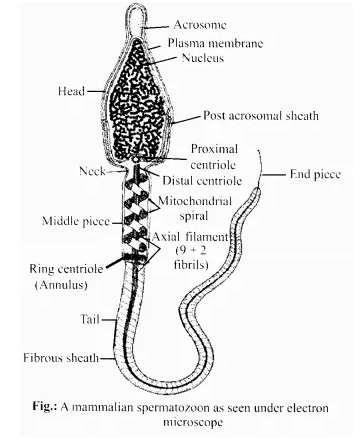
Question 10.
What are the major components of seminal plasma?
Solution:
Secretions of prostate gland, seminal vesicle and Cowper’s gland and , sperms together constitute semen.
Question 11.
What are the major functions of male accessory ducts and glands?
Solution:
The main functions of male accessory ducts and glands are as follows:
1. Functions of accessory ducts:
- Rete Testis: They transport sperms from seminiferous tubule to Vas efferentia.
- Vas efferentia: Transports sperms to epdidymis.
- Epididymis: Sperms are stored here. Maturation of sperms occurs.
- Vas deference: Transports sperms from the epididymis to the urethra.
2. Functions of glands:
- Prostate gland: It produces milky secretion which forms a considerable part of the semen. It makes sperm motile.
- Bulbourethral gland: Its secretion makes the penis lubricated.
- Seminal vesicle: It secretes mucus and watery alkaline fluid which provide energy to the sperm.
Question 12.
What is oogenesis? Give a brief account of oogenesis.
Solution:
Oogenesis is the production and growth of the ova (egg cell) in the ovary. It starts only after the female has attained puberty. The process is induced by FSH from the anterior pituitary. It leads to the growth of a single Graafian follicle in one of the two ovaries every month. The developing ovary is colonised by primordial germ cells prior to birth which differentiate into oogonia. These enlarge within the follicle under the influence of mitotic division to form primary oocyte containing diploid number of chromosomes. These undergo reductional division (1st meiotic division) to form a secondary oocyte and first polar body. The secondary oocyte proceeds with meiosis II but the division gets arrested until fertilisation occurs. The ‘egg’ is released at secondary oocyte stage under the effect of LH. A second polar body is extruded. The first polar body may also divide to form two polar bodies of equal sizes which do not take part in reproduction and ultimately degenerates. During oogenesis one oogonium produces one ovum and three polar bodies. Polar bodies containing small amount of cytoplasm helps to retain sufficient amount of cytoplasm in the ovum which is essential for the development of early embryo. Formation of polar bodies maintains the half number of chromosomes in the ovum.
Question 13.
Draw a labelled diagram of a section through ovary.
Solution:
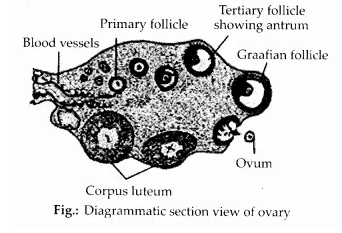
Question 14.
Draw a labelled diagram of a Graafian follicle ?
Solution:
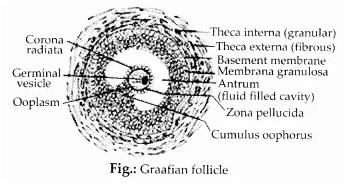
Question 15.
Give the functions of the following.
- Corpus luteum
- Endometrium
- Acrosome
- Sperm tail
- Fimbriae
Solution:
The functions of the following:
- Corpus luteum secretes a large amount of progesterone which is essential for the maintenance of the endometrium of the uterus.
- Endometrium is necessary for the implantation of the fertillised ovum, for contributing towards the making of the placenta and other events of pregnancy.
- Acrosome is filled with enzymes that help in dissolving the outer cover of the ovum and entry of sperm nucleus.
- Sperm tail facilitates motility of the sperm essential for reaching the ovum to fertilize it.
- Fimbriae are fingers-like projections at the mouth of fallopian tubules that help in the collection of the ovum after ovulation.
Question 16.
Identify True/False statements. Correct each false statement to make it true.
- Androgens are produced by Sertoli cells.
- Spermatozoa get nutrition from Sertoli cells.
- Leydig cells are found in ovary.
- Leydig cells synthesise androgens.
- Oogenesis takes place in corpus luteum.
- Menstrual cycle ceases during pregnancy.
- Presence or absence of a hymen is not a reliable indicator of virginity Or sexual experience.
Solution:
- False: Androgens are produced by interstitial cells or Leydig cells.
- True
- False: Leydig’s cells are found in the testes (in between the seminiferous tubules).
- True
- False: Oogenesis takes place in the ovary.
- True
- True
Question 17.
What is the menstrual cycle? Which hormones regulate the menstrual cycle?
Solution:
The recurring cycle of physiological changes in the uterus, ovaries and other sexual structures that occur from the beginning of one menstrual period through the beginning of the next is called menstrual cycle. The beginning of menstruation is called menarche. Hormones involved in the regulation of menstrual cycle are pituitary or ovarian hormones. These are LH, FSH, estrogen and progesterone.
Question 18.
What is parturition? Which hormones are involved in the induction of parturition?
Solution:
- The process of delivering of the fully developed fetus or baby at the end of the pregnancy period through vigorous contraction of the uterus is called parturition.
- Estrogen (amount of estrogen is more than progesterone) and oxytocin are the hormones involved in the induction of parturition.
Question 19.
In our society, women are often blamed for giving birth to daughters. Can you explain why this is not correct?
Solution:
This is not correct that women in our society are often blamed for giving birth to daughters because the sex of the baby is determined by the father, not by the mother. As we know that the chromosome pattern in the human female is XX and that in the male is XY.
Therefore, all the haploid gametes produced by the female (ova) have the sex chromosome X whereas in the male gametes (sperms) the sex chromosome could be either X or Y, hence, 50 per cent of sperms carry the X chromosome while the other 50 per cent carry the Y. After fusion of the male and female gametes the zygote would carry either XX or XY depending on whether the sperm carrying X or Y fertilised the ovum. The zygote carrying XX would develop into a female baby and XY would form a male.
Question 20.
How many eggs are released by a human ovary in a month? How many eggs do you think would have been released if the mother gave birth to identical twins? Would your answer change if the twins born were fraternal?
Solution:
Each ovary develops a number of immature eggs associated with groups of other cells called follicles. Normally, in humans, only one egg is released at one time; occasionally, two or more erupt during the menstrual cycle. The egg erupts from the ovary on the 14th to 16th day of the approximately 28 day menstrual cycle. Identical twins occur when a single egg is fertilised to form one zygote (monozygotic) which then divides into two separate embryos. And if the twins were born fraternal two eggs are released. Fraternal twins (commonly known as “non-identical twins”) usually occur when two fertilised eggs are implanted in the uterine wall at the same time. The two eggs form two zygotes, and these twins are therefore also known as dizygotic as well as “binovular” twins.
Question 21.
How many eggs do you think were released by the ovary of a female dog which gave birth to 6 puppies?
Solution:
One oogonium produces one ovum and three polar bodies. The ovum is the actual female gamete. The polar bodies take no part in reproduction and hence, soon degenerate. In human beings, ovum is released from the ovary in the secondary oocyte stage. So, six ova (eggs), were released by ovary of a female dog which gave birth to 6 puppies.
We hope the NCERT Solutions for Class 12 Biology Chapter 3 Human Reproduction help you. If you have any query regarding NCERT Solutions for Class 12 Biology Chapter 3 Human Reproduction, drop a comment below and we will get back to you at the earliest.
Class 12 Biology NCERT Solutions
- Reproduction in Organisms Class 12 Question Answer
- Sexual Reproduction in Flowering Plants Class 12 Question Answer
- Human Reproduction Class 12 Question Answer
- Reproductive Health Class 12 Question Answer
- Principles of Inheritance and Variation Class 12 Question Answer
- Molecular Basis of Inheritance Class 12 Question Answer
- Evolution Class 12 Question Answer
- Human Health and Diseases Class 12 Question Answer
- Strategies for Enhancement in Food Production Class 12 Question Answer
- Microbes in Human Welfare Class 12 Question Answer
- Biotechnology: Principles and Processes Class 12 Question Answer
- Biotechnology and Its Applications Class 12 Question Answer
- Organisms and Populations Class 12 Question Answer
- Ecosystem Class 12 Question Answer
- Biodiversity and Conservation Class 12 Question Answer
- Environmental Issues Class 12 Question Answer